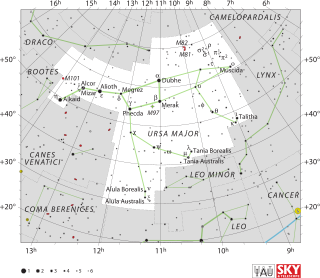LAMOST J112456.61+453531.3 (unofficial abbreviation J1124+4535) is a magnitude 13.98 star in the constellation Ursa Major, below the "bowl" of the Big Dipper.[3][1] It is located approximately 60,000 light-years from Earth.[2]
| Observation data Epoch J2000 Equinox J2000 | |
|---|---|
| Constellation | Ursa Major |
| Right ascension | 11h 24m 56.6107s |
| Declination | +45° 35′ 31.3073″ |
| Apparent magnitude (V) | 13.979[1] |
| Characteristics | |
| B−V color index | 0.850[1] |
| Astrometry | |
| Proper motion (μ) | RA: −0.857±0.025 mas/yr Dec.: −6.784±0.031 mas/yr |
| Parallax (π) | 0.0577 ± 0.0226 mas[2] |
| Distance | approx. 60,000 ly (approx. 17,000 pc) |
| Details | |
| Temperature | 4897.5[2] K |
| Database references | |
| SIMBAD | data |
Initial observations of J1124+4535 by the Large Sky Area Multi-Object Fibre Spectroscopic Telescope showed low amounts of magnesium, and later, the Subaru Telescope confirmed the low amounts of magnesium and also found high amounts of europium. J1124+4535 also lacks the same observable chemical signature as other stars in its parent interstellar cloud, indicating that J1124+4535 did not form in the cloud, confirming that the star must have formed outside the Milky Way.[4]
The star's origin was most likely the result of a dwarf galaxy collision with the Milky Way some 5 to 9 billion years ago. The remnants of the destroyed galaxy can still be seen as the most visible streams of the galactic halo.[5][6]
References
edit- ^ a b c Arne A. Henden (2016), "AAVSO Photometric All Sky Survey (APASS) DR9", vizier.u-strasbg.fr, retrieved 12 May 2019
- ^ a b c Brown, A. G. A.; et al. (Gaia collaboration) (August 2018). "Gaia Data Release 2: Summary of the contents and survey properties". Astronomy & Astrophysics. 616. A1. arXiv:1804.09365. Bibcode:2018A&A...616A...1G. doi:10.1051/0004-6361/201833051. Gaia DR2 record for this source at VizieR.
- ^ Matsuno, Tadafumi; Ishigaki, Miho N.; Li, Hai-Ning; Honda, Satoshi; Aoki, Wako; Zhao, Gang; Xing, Qian-Fan (2019-04-29). "Evidence for the accretion origin of halo stars with an extreme r-process enhancement". Nature Astronomy. 3 (7): 631–635. arXiv:1905.04141. Bibcode:2019NatAs...3..631X. doi:10.1038/s41550-019-0764-5. ISSN 2397-3366. S2CID 150373875.
- ^ "Milky Way star with strange chemistry is from dwarf galaxy". ScienceDaily. Retrieved 2 May 2019.
- ^ Irving, Michael (May 2019). "Star unlike any found in the Milky Way appears to be an intergalactic intruder". newatlas.com. Retrieved 2 May 2019.
- ^ Young, Monica (5 March 2018). "Dwarf Galaxy Collision Evicted Milky Way Stars". Sky & Telescope. Retrieved 3 July 2019.
